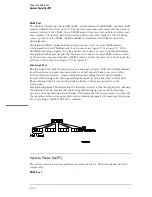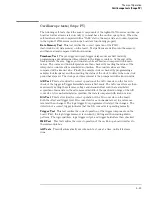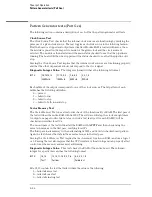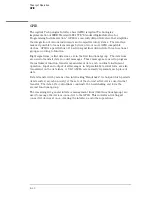
RS-232-C
The logic analyzer interfaces with RS-232-C communication lines through a standard
25-pin D connector. The logic analyzer is compatible with RS-232-C protocol. When
a hardwire handshake method is used, the Data Terminal Ready (DTR) line, pin 20
on the connector, is used to signal if space is available for more data in the logical I/O
buffer. Pin outs of the RS-232-C connectors are listed in the following table.
RS-232-C Signal Definitions
Pin
Number
Function
RS-232-C
Standard
Signal Direction and Level
1
Protective Ground
AA
Not applicable
2
Transmitted Data (TD)
BA
Data from Mainframe
High = Space = "0" = +12 V
Low = Mark = "1" = –12 V
3
Received Data (RD)
BB
Data to Mainframe
High = Space = "0" = +3 V to +25 V
Low = Mark = "1" = –3 V to –25 V
4
Request to Send (RTS)
CA
Signal from Mainframe
High = ON = +12 V
Low = OFF = –12 V
5
Clear to Send (CTS)
CB
Signal to Mainframe
High = ON = +3 V to +12 V
Low = OFF = –3 V to –25 V
6
Data Set Ready (DSR)
CC
Signal to Mainframe
High = ON = +3 V to +25 V
Low = OFF = –3 V to –25 V
7
Signal Ground
AB
Not applicable
8
Data Carrier Detect (DCD)
CF
Signal to Mainframe
High = ON = +3 V to +25 V
Low = OFF = –3 V to –25 V
20
Data Terminal Ready (DTR)
CD
Signal from Mainframe
High = ON = +12 V
Low = OFF = –12 V
23
Data Signal Rate Selector
CH/CI
Signal from Mainframe
Always High = ON = +12 V
Theory of Operation
RS-232-C
8–32
Summary of Contents for 1670G Series
Page 20: ...1 12...
Page 116: ...Testing Performance Performance Test Record pattern generator 3 92...
Page 126: ...Calibrating and Adjusting To test the CAL OUTPUT ports 4 10...
Page 166: ...Exploded View of the Agilent 1670G series logic analyzer Replacing Assemblies 6 4...
Page 201: ...Theory of Operation The Oscilloscope Board 8 11...



































